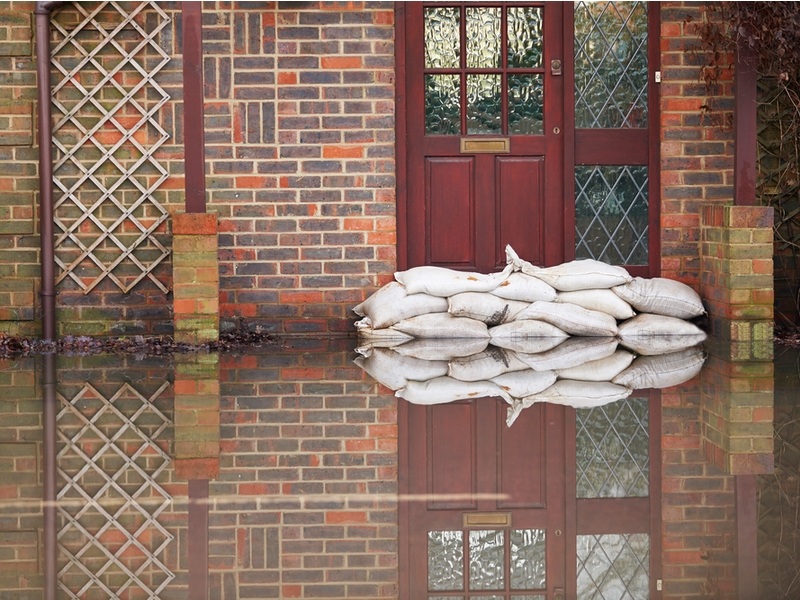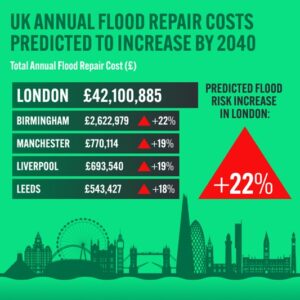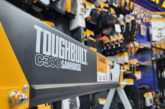
– Subsistence repair costs estimated to reach £15,000 per household by 2040
– Floor and wall damage could reach £7,000
As climate change increases the prevalence of extreme weather events in the UK, household repair costs are estimated to increase alongside this. That’s according to a new report by Protrade, a leading UK-based provider of power tools and associated products, which revealed the impact of climate change on the construction and trade industries.
Tradespeople such as roofers, electricians and builders should expect to see increased revenue, with annual property repair work across the UK’s 20 most populous cities estimated to reach over £144 million by 2040.
As extreme weather becomes increasingly common, climate-related risks are no longer a distant threat; they’re a growing reality for homeowners and the tradespeople who maintain their properties. To explore the scale of this impact, Protrade analysed climate projections, housing data, and repair cost estimates across the country.
Drawing on UKCP18 data from the Met Office, Protrade calculated future levels of flood exposure and heatwave vulnerability by city. They then applied average repair costs for common climate-related damage – including subsidence, HVAC stress, damp, drainage, and structural fixes – to estimate the potential annual repair bill and identify which areas of property maintenance are likely to see the biggest rise in demand.

On these findings, Des Duddy, Joint Managing Director at Protrade, comments: “With projected repair costs across the 20 largest UK cities exceeding £144 million annually, this highlights the growing financial strain climate change could place on the housing sector if adaptive measures aren’t taken. As temperatures rise and extreme rainfall becomes more frequent, demand for both structural and surface-level repair is likely to surge – particularly in major urban centres like London and Birmingham.”
Subsistence repair costs estimated to reach £15,000 per household by 2040 due to heatwaves
| Rank | Damage Type | Estimated Cost (£) |
| 1 | Subsidence repairs | £15,000 |
| 2 | HVAC installation/upgrade | £3,500 |
| 3 | Electrical/fire-related damage | £3,000 |
| 4 | Roof/material repairs | £2,500 |
| 5 | Pipework/internal cracking | £1,800 |
Subsidence repairs are set to become the most expensive heat-related repair, with average costs reaching £15,000 per property. As temperatures continue to rise, more homes will also require HVAC installations/upgrades (costing £3,500) to keep indoor conditions safe during extreme heat.
Heatwaves will lead to roof and material degradation, with typical repair costs of around £2,500 and an increased demand for plasterers and tilers. On top of this, pipework and internal cracking, averaging £1,800 per incident, will increase with more frequent heatwaves caused by the expansion and contraction of materials in fluctuating heat.

Des adds: “As climate change progresses, we’re expecting a significant rise in demand for certain types of repair work by 2040. Subsidence repairs are likely to become more common as prolonged dry spells cause clay soils to shrink, threatening the structural stability of buildings. Add to that the projected increase in roof degradation, cracked materials, and internal damage from heat expansion, it’s clear the workload for tradespeople is set to grow massively over the next 15 years.”
Wall and floor damage costs could reach £7,000 by 2040 for households due to flooding and wet weather
| Rank | Damage Type | Estimated Cost (£) |
| 1 | Wall and floor damage | £7,000 |
| 2 | Furniture and appliances damage | £5,000 |
| 3 | Drying and cleanup | £2,500 |
| 4 | Damp or water ingress | £2,250 |
| 5 | Gutter and drainage fixes | £1,000 |
Flooding is expected to drive up a wide range of property repair costs by 2040, with wall and floor flood damage topping the list at an average of £7,000 per property. It will also result in more furniture and appliance losses, averaging £5,000 in repairs, particularly in ground-floor properties where water ingress can destroy electronics, soft furnishings, and white goods.
Other repairs that will see an increased demand include drying and clean-up jobs (£2,500), persistent damp and water ingress (£2,250), especially in older or poorly sealed homes, and gutter and drainage fixes (£1,000).

For further information, including the estimated repair costs in your city, visit Protrades’ full Climate Change Home Repair Cost Report



